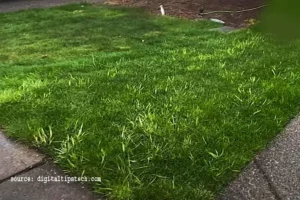Why Is My Grass Turning White?, The pride of numerous homeowners lies in their ability to maintain a lush, green lawn. However, when you notice your grass turning white or developing white patches, it can be concerning. Several factors can contribute to this problem, ranging from natural causes to lawn care practices. In this article, we will explore the common reasons why your grass might be turning white and provide effective solutions to restore your lawn’s health.
Fungal Infections:
One of the primary culprits behind white grass is fungal infections. Two common fungal diseases responsible for this issue are powdery mildew and snow mold. Powdery mildew appears as white powdery spots on the grass blades, while snow mold results in white or grayish patches. These fungi thrive in cool, damp conditions, such as early spring or fall when the weather is moist, but the ground has not frozen.

Solution:
To combat fungal infections, practice good lawn hygiene. Remove fallen leaves and debris promptly, as they create a favorable environment for fungi to grow. Additionally, ensure your lawn has adequate airflow and sunlight to discourage fungal growth.
Excessive Thatch:
The layer of dead grass, roots, and other natural waste that gathers between the soil and the lush green blades is known as thatch. When thatch builds up excessively, it can hinder water penetration, nutrient absorption, and air circulation. As a result, the grass may turn white or pale due to stress and malnourishment.
Solution: Periodic dethatching can help control this issue. Use a dethatching rake or machine to remove the excess thatch and allow your lawn to breathe freely. Following dethatching, aerate the lawn to improve soil compaction and encourage root growth.
Insect Infestations:
Insects, such as grubs, can cause severe damage to your lawn by feeding on the grassroots. As the roots weaken, the grass loses its ability to take up nutrients and water, leading to white or brown patches in the affected areas.
Solution: Identify the presence of pests in your lawn and take appropriate measures to eliminate them. You can use natural predators or apply targeted insecticides to control the infestation. Regularly inspect your lawn to catch any pest issues early on.
Chemical Issues:
Overusing fertilizers or herbicides can cause chemical burns to the grass, resulting in white or yellow patches. Misapplication or using the wrong type of chemicals can harm the grass instead of promoting healthy growth.
Solution: Follow the recommended guidelines for fertilizing and apply herbicides carefully. Consider using organic or slow-release fertilizers to minimize the risk of chemical burns.
Extreme Heat and Drought:
During periods of intense heat and drought, grass may turn white as a survival mechanism. Grass can go dormant to conserve water and energy until more favorable conditions return.
Solution: When experiencing extreme heat and drought, water your lawn deeply and less frequently. Watering in the early morning or late evening aids in minimizing water loss caused by evaporation.
Improper Mowing:
Mowing your lawn too short can stress the grass and cause it to turn white. Scalping the lawn weakens the grass, making it susceptible to damage and diseases.

Solution: Adjust your mower’s cutting height to ensure you’re only removing one-third of the grass blade’s length with each mowing session. Maintaining a proper mowing height promotes healthier grass and reduces stress.
How do I fix white patches on my lawn?
To fix white patches on your lawn, you’ll need to identify the underlying cause and take appropriate actions. Here are some general steps to address the issue:
Identify the Cause: Before you start treating the white patches, try to determine the cause. As mentioned earlier, white patches can be caused by fungal infections, excessive thatch, insect infestations, chemical issues, extreme heat and drought, or improper mowing.
Fungal Infections:
Use a fungicide: Apply a fungicide specifically designed to treat the type of fungus affecting your lawn. Follow the instructions carefully and apply it during the appropriate weather conditions.
Improve airflow and sunlight: Trim overhanging branches and remove obstacles that may hinder airflow and sunlight to the affected areas.
Excessive Thatch:
Dethatch the lawn: Use a dethatching rake or machine to remove the excessive thatch and allow better airflow and water penetration.
Aerate the lawn: After dethatching, aerate the lawn to relieve soil compaction and promote root growth.
Insect Infestations:
Identify the pests: Determine the type of insects causing the damage.
Apply insecticides: Use targeted insecticides to control the specific pests. Consider using natural predators to manage the infestation, if possible.
Chemical Issues:
Adjust fertilizer and herbicide use: Follow the recommended guidelines for applying fertilizers and herbicides. Avoid overusing these chemicals to prevent chemical burns.
Extreme Heat and Drought:
Deep watering: Water your lawn deeply and less frequently during extreme heat and drought to encourage deeper root growth and reduce stress on the grass.
Improper Mowing:
Adjust mowing height: Raise the cutting height of your mower to prevent scalping the grass and allow it to grow healthier.
Re-seeding or Re-sodding: For severely damaged areas, you may need to reseed or re-sod the white patches. Choose grass seed or sod that is suitable for your climate and soil type.
Regular Lawn Maintenance: To prevent future white patches and maintain
A healthy lawn: Keep your lawn well-groomed by mowing it consistently at the correct height. Water your lawn deeply and consistently, especially during dry periods. Follow the recommended schedule for fertilizing your lawn. Control thatch buildup through regular dethatching and aeration.
it’s essential to address the specific cause of the white patches to effectively fix the issue. If you’re unsure about the cause or the appropriate solution, consider seeking advice from a lawn care professional or a local gardening expert.
Final Quote:
The appearance of white grass can indicate various issues affecting your lawn’s health. By identifying the underlying causes and implementing the appropriate solutions, you can restore your lawn’s vibrancy and lush green appearance. Regular lawn maintenance, proper watering, and attentive care will help prevent future problems and keep your lawn looking its best year-round.